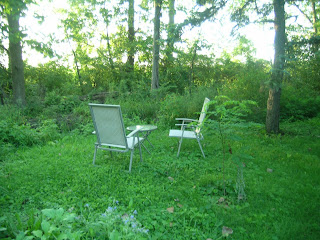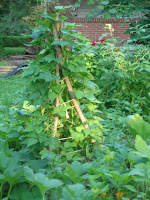
Firewood
We put a Vermont Castings woodburning stove in our house in 2007. I think the guy who installed it thought we were a little nutty because when he explained a few things to us it was apparent that we had no idea how to build a fire. We kept giving him blank looks and I think he left hoping we wouldn't burn down our house.
Last year it was such a big deal for us to build a fire and it took the better part of an afternoon to really get it going and start heating up the house. We have gotten a lot faster at it and we really enjoy the heat that comes from the stove. It is so much more comforting and relaxing than the kind of heat from our gas furnace. We think we have discovered that the reason the heat is so much better is because it heats everything - the bricks, the walls, our bodies - instead of just heating the air like the forced air heat from the gas furnace. There is something delicious and wonderful about connecting with the primitive nature of real fire that is truly warming when it is cold and dreary outside. It is difficult for us to pry ourselves away from the fire in the winter and I often fall asleep reading by it in the evening.

Cozy fire in our Vermont Castings stove
Some people who are concerned about sustainability have chosen not to use wood for heat because they are concerned about pollution. The argument goes that if everyone had a woodburning stove in the winter the air could become very smoky and, although trees are a renewable resource, we might use up too many of our forests. This is a fair argument and one we thought seriously about as well. However, in the end, we have chosen to use wood over gas, coal, and oil because we feel that it is a local, renewable resource, and because it puts us in direct contact with our consumption. We have to work (and we will explain just how MUCH we have to work) to heat our home by gathering wood and building the fire. This give us a direct connection with the source of our heat and with our footprint on the earth.
So, to get back to our process... the first step was to choose the stove we wanted and get it installed in our house. We also looked at pellet stoves because they are a little easier to deal with, but they use electricity to feed the pellets into the stove and our goal is to get "off the grid" as much as we can. Also, you have to purchase the pellets from someone, and we wanted to develop more independence as consumers. We chose the Vermont Castings stove and had it installed, and then set about learning how to build a fire.
But, oh - how could I forget...THE FIREWOOD!

Where do you get firewood when you are college educated teachers - intellectual subanites? We hadn't a clue! We bought some wood from the place we bought our wood stove from and we also bought some wood from a local farmer. But it started to bother us to have to pay so much for wood, so we started foraging for wood and looking for free wood offers on Craig's List. Then last year we had a huge storm caused by a hurricane in the Gulf Coast and trees were down all over the place around here. People were chopping up trees and leaving them by the curb as yard waste, so Saul took the pick-up and collected wood like a fiend. He gathered about a 2-3 year's supply of wood at least! I think collecting the wood tapped into his hunting and gathering instinct!
OK, so we had the stove, we had a bunch of wood, but we then had to CUT and SPLIT it. Oh my, what to do? We both have a healthy fear of chain saws, so we hired someone to cut it into lengths that would fit into the stove. Then we tried a number of electric wood splitters, but they weren't really powerful enough to split some of the large stumps we had. Finally, through some community networking that happens when you live in a small town, Saul found out about a gas wood splitter that someone was willing to loan us free of charge. It was a large one - 27 tons of pressure! We borrowed the wood splitter and Saul went to work...for almost the entire summer of 2009! What a job! It was a very physical job for a college professor and it was a lot of hard work, but Saul persevered and we are very well set for firewood for at least a few years.

Saul's summer vacation
The last step in the process was to organize and STACK all the firewood, which was also new to us. We had no idea there were so many things you have to do in order to build a cozy fire in your newly purchased woodburning stove! Before we could stack the wood we had to have some place to stack it, so that was a decision-making process. We learned that it's probably not a great idea to stack it against the house because of termites (which we had already done and we are using that wood up this winter), so we had to have some kind of structure to put the wood on. The first time we stacked it most of the stack fell down, which was very disconcerting, but we finally got our log stackers (which we ordered off the internet and assembled) and we got the all the wood stacked. Whew!

Sooooo....just to reiterate the things we did:
1. Picked out the stove at the store (took some doing).
2. Had the stove installed (took some doing).
3. FOUND firewood (had to learn where).
4. Hired someone to CUT the wood (the easy part).
5. Borrowed a lot splitter and SPLIT the wood (oh man!).
6. Ordered and assembled log stackers and STACKED the wood (backbreaking).
7. Learned how to build a fire and BURN the wood (took some doing).
8. Enjoyed our fire (haven't burned down the house yet).
9. Felt like pioneers from "Little House on the Prairie" (little energy efficient house in Yellow Springs)
10. Wrote this blog post (brag, brag).

Voila! Stacked wood!





















